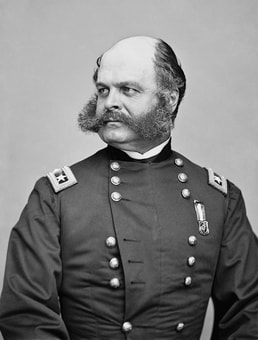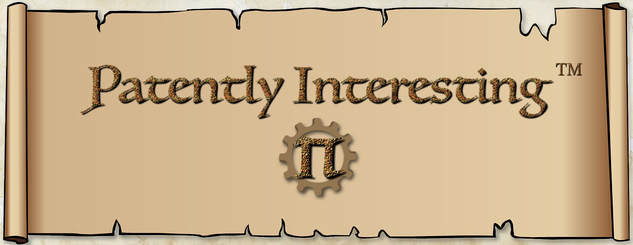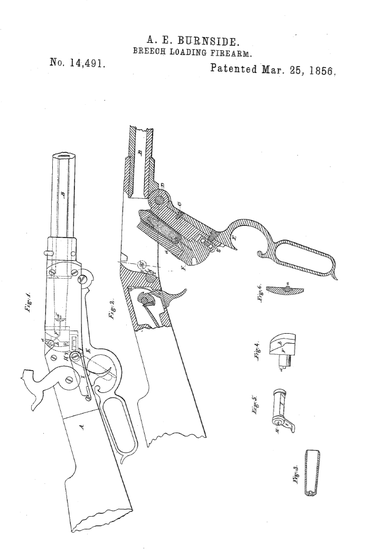 General Ambrose Burnside
General Ambrose Burnside
On March 25 of the year 1856, U.S. Patent No.: 14,491 issued to Ambrose Burnside for a "Breech Loading Firearm". Burnside would later become a General in the Union Army during the American Civil War, with a mixed service record. He was known for the unusual style in which he maintained his facial hair, from which the term "sideburn" is derived. After the Civil War, Burnside served as Governor and Senator for Rhode Island and was a president for several railroads. Burnside was also the first president of the National Rifle Association.
Burnside was born in Liberty, Indiana and attended the United States Military Academy at Westpoint. After graduating from Westpoint in 1847, Burnside became a commissioned officer in the U.S. Army and was sent to Mexico at the end of the Mexican-American war. Later, he served in a light artillery unit that had been converted to cavalry duty to protect the Western mail routes through Nevada. In 1849, Burnside was wounded by an arrow in his neck during a skirmish against Apaches, outside of Las Vegas, New Mexico. In that fight, Burnside and his troops had to rely solely on their sabers because their muzzle loading rifles were impractical to use while on horseback and they were not equipped with revolvers, which were not yet in widespread use. Burnside noted this deficiency in weaponry and began to think about developing a breech loading carbine.
In September of 1851, Burnside was ordered to return to Washington D.C. with dispatches from the western frontier. On his long ride back, Burnside mentally designed a new breech loading carbine. After his arrival in Washington, Burnside turned his mental design into a prototype carbine, which was well received by his fellow officers. Indeed, initial testing showed Burnside's new breech-loading carbine to be far superior to other breech-loading carbines that had been recently developed by other inventors.
Burnside's carbine had a breech block that was pivotally connected to a stock of the carbine so as to move between a lower, loading position and an upper, firing position. The breech block was pivoted between the two positions by an elongated trigger guard. Inside the breech block was a cavity for receiving a specially-shaped metal cartridge. The cartridge was loaded into the cavity when the breech block was pivoted downward to the loading position. When the breech block was pivoted upward to the firing position, a front, tapered portion of the cartridge was inserted into the entrance of a barrel of the carbine, while an opening in a rear portion of the cartridge received the end of a breech pin that was driven into the cartridge when a trigger of the carbine was pulled.
Burnside continued to develop his carbine after he was transferred to Fort Adams in Rhode Island in 1852. The following year, Burnside resigned from the Army and moved to Bristol, Rhode Island, with his new wife, Mary. With money he borrowed from friends, Burnside started the Bristol Rifle Works to manufacture his carbine. At first, sales were slow, but then picked up when the company received an order for several hundred carbines from Jefferson Davis, who, at the time, was the Secretary of War under President Franklin Pierce and would later became President of the Confederate States of America.
In early 1857, the business prospects for Burnside's fledgling company were looking up. The new Secretary of War, John B. Floyd, verbally agreed to award the company a large contract to provide breech-loading carbines for all of the U.S. cavalry, provided the carbines passed testing. In August, the Army held carbine trials at Westpoint in which the breech- loading carbines of eighteen different inventors were tested. A board of officers judging the tests unanimously found that Burnside's breech-loading carbine was "best suited for the military service". Based upon his verbal agreement with Floyd and the success of his carbine at the Westpoint trials, Burnside cranked up the production of his carbines at his Bristol factory, but, in doing so, he also cranked up his outstanding debt.
Not long after the Westpoint trials, Burnside's fortunes took a turn for the worse. The Panic of 1857 hit and Floyd decided that a second carbine trial must be conducted. Although Burnside's carbine also won the second carbine trial, Burnside knew he was in trouble when he was approached one night by a man who advised Burnside that he would be given the Army contract for breech-loading carbines only if he agreed to pay $5,000 (as a bribe). Being a thoroughly honest man, Burnside indignantly refused to do so. As a consequence, Floyd only awarded Burnside's company a token order, instead of the contract for the entire U.S. cavalry. This spelled trouble for the Bristol Rifle Works and financial ruin for Burnside.
Unable to collect on debts owed to him due to the Panic and unable to recoup his outlays for the lost Army contract, Burnside could no longer keep his company a going concern. He declined help from family and friends and eschewed bankruptcy proceedings. Instead, he sold everything he owned, including his uniform, sword and the '491 patent, to pay a portion of the debt he owed to the creditors of the Bristol Rifle Works. Working diligently and living frugally, Burnside was able to pay the remaining debt by 1860.
In the meantime, the Bristol Rifle Works was reorganized and regained its financial footing. The company began to receive large orders for Burnside carbines from the War Department due to the favorable response they received from soldiers who were equipped with them. Indeed, by the time the Civil War broke out, the War Department was buying thousands of the Burnside carbines. In the final tally, the Burnside carbine was the third most popular carbine utilized by the Union cavalry in the Civil War, exceeded only by the Sharps and Spencer carbines.
Burnside never shared in any of the profit made from the sales of his carbine, but he did finally get the satisfaction of seeing his carbine in action. After the Civil War broke out, Burnside was given command of the 1st Rhode Island Volunteer Infantry Regiment and, within this Regiment, a company of sharpshooters were armed with Burnside carbines.
Burnside was born in Liberty, Indiana and attended the United States Military Academy at Westpoint. After graduating from Westpoint in 1847, Burnside became a commissioned officer in the U.S. Army and was sent to Mexico at the end of the Mexican-American war. Later, he served in a light artillery unit that had been converted to cavalry duty to protect the Western mail routes through Nevada. In 1849, Burnside was wounded by an arrow in his neck during a skirmish against Apaches, outside of Las Vegas, New Mexico. In that fight, Burnside and his troops had to rely solely on their sabers because their muzzle loading rifles were impractical to use while on horseback and they were not equipped with revolvers, which were not yet in widespread use. Burnside noted this deficiency in weaponry and began to think about developing a breech loading carbine.
In September of 1851, Burnside was ordered to return to Washington D.C. with dispatches from the western frontier. On his long ride back, Burnside mentally designed a new breech loading carbine. After his arrival in Washington, Burnside turned his mental design into a prototype carbine, which was well received by his fellow officers. Indeed, initial testing showed Burnside's new breech-loading carbine to be far superior to other breech-loading carbines that had been recently developed by other inventors.
Burnside's carbine had a breech block that was pivotally connected to a stock of the carbine so as to move between a lower, loading position and an upper, firing position. The breech block was pivoted between the two positions by an elongated trigger guard. Inside the breech block was a cavity for receiving a specially-shaped metal cartridge. The cartridge was loaded into the cavity when the breech block was pivoted downward to the loading position. When the breech block was pivoted upward to the firing position, a front, tapered portion of the cartridge was inserted into the entrance of a barrel of the carbine, while an opening in a rear portion of the cartridge received the end of a breech pin that was driven into the cartridge when a trigger of the carbine was pulled.
Burnside continued to develop his carbine after he was transferred to Fort Adams in Rhode Island in 1852. The following year, Burnside resigned from the Army and moved to Bristol, Rhode Island, with his new wife, Mary. With money he borrowed from friends, Burnside started the Bristol Rifle Works to manufacture his carbine. At first, sales were slow, but then picked up when the company received an order for several hundred carbines from Jefferson Davis, who, at the time, was the Secretary of War under President Franklin Pierce and would later became President of the Confederate States of America.
In early 1857, the business prospects for Burnside's fledgling company were looking up. The new Secretary of War, John B. Floyd, verbally agreed to award the company a large contract to provide breech-loading carbines for all of the U.S. cavalry, provided the carbines passed testing. In August, the Army held carbine trials at Westpoint in which the breech- loading carbines of eighteen different inventors were tested. A board of officers judging the tests unanimously found that Burnside's breech-loading carbine was "best suited for the military service". Based upon his verbal agreement with Floyd and the success of his carbine at the Westpoint trials, Burnside cranked up the production of his carbines at his Bristol factory, but, in doing so, he also cranked up his outstanding debt.
Not long after the Westpoint trials, Burnside's fortunes took a turn for the worse. The Panic of 1857 hit and Floyd decided that a second carbine trial must be conducted. Although Burnside's carbine also won the second carbine trial, Burnside knew he was in trouble when he was approached one night by a man who advised Burnside that he would be given the Army contract for breech-loading carbines only if he agreed to pay $5,000 (as a bribe). Being a thoroughly honest man, Burnside indignantly refused to do so. As a consequence, Floyd only awarded Burnside's company a token order, instead of the contract for the entire U.S. cavalry. This spelled trouble for the Bristol Rifle Works and financial ruin for Burnside.
Unable to collect on debts owed to him due to the Panic and unable to recoup his outlays for the lost Army contract, Burnside could no longer keep his company a going concern. He declined help from family and friends and eschewed bankruptcy proceedings. Instead, he sold everything he owned, including his uniform, sword and the '491 patent, to pay a portion of the debt he owed to the creditors of the Bristol Rifle Works. Working diligently and living frugally, Burnside was able to pay the remaining debt by 1860.
In the meantime, the Bristol Rifle Works was reorganized and regained its financial footing. The company began to receive large orders for Burnside carbines from the War Department due to the favorable response they received from soldiers who were equipped with them. Indeed, by the time the Civil War broke out, the War Department was buying thousands of the Burnside carbines. In the final tally, the Burnside carbine was the third most popular carbine utilized by the Union cavalry in the Civil War, exceeded only by the Sharps and Spencer carbines.
Burnside never shared in any of the profit made from the sales of his carbine, but he did finally get the satisfaction of seeing his carbine in action. After the Civil War broke out, Burnside was given command of the 1st Rhode Island Volunteer Infantry Regiment and, within this Regiment, a company of sharpshooters were armed with Burnside carbines.



